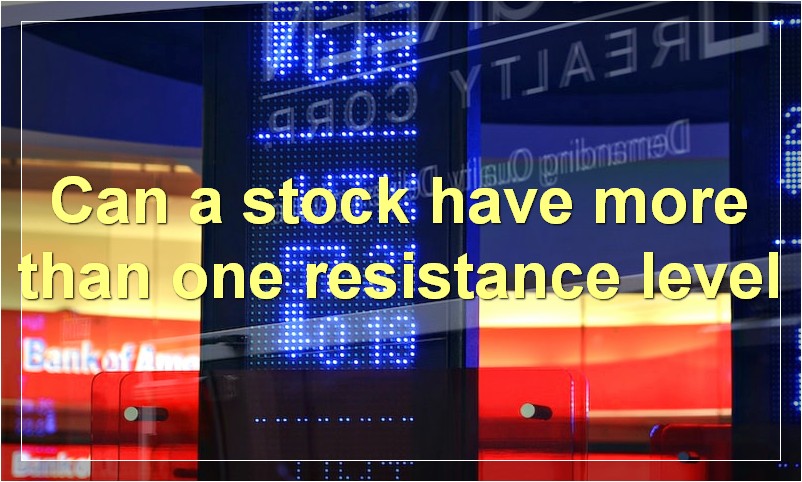If you’re thinking about investing in stocks, it’s important to understand the different levels of resistance a stock might have. By understanding resistance levels, you can make more informed investment decisions and avoid potential losses.
What is a stock resistance level
When it comes to stocks, resistance level is a price point at which selling is thought to be strong enough to prevent the stock from climbing any higher. In other words, it’s a ceiling for the stock price.
If the stock price reaches the resistance level and then starts to fall, that’s a good indication that the level was indeed acting as resistance. On the other hand, if the stock breaks through the resistance level, that could be a sign that further gains are in store.
There are a number of factors that can contribute to a stock’s resistance level, such as the overall market conditions, the stock’s recent performance, and analyst ratings. Resistance levels can also change over time, so it’s important to keep an eye on them.
If you’re thinking about buying a stock, it’s a good idea to take a look at its resistance level. If the stock is close to the resistance level, you may want to wait to see if it breaks through before making your purchase. But if the stock is well below the resistance level, it may be a good time to buy.
What are the factors that affect a stock’s resistance level

A stock’s resistance level is the price point at which it becomes more difficult for the stock to rise. There are a number of factors that can affect a stock’s resistance level, including the overall market conditions, the company’s financial stability, and investor sentiment. When the market is weak, stocks tend to have lower resistance levels. This is because investors are generally more hesitant to buy stocks when the market is down. On the other hand, when the market is strong, stocks tend to have higher resistance levels. This is because investors are generally more confident in the market and are willing to pay more for stocks. The company’s financial stability is also a major factor in determining resistance levels. A company that is financially stable and has a strong track record will typically have higher resistance levels than a company that is not as financially stable or does not have a strong track record. Investor sentiment is another important factor that can affect resistance levels. If investors are bullish on a particular stock, they may be willing to pay more for it, resulting in a higher resistance level. Conversely, if investors are bearish on a stock, they may be less willing to pay for it, resulting in a lower resistance level.
How can you identify a stock’s resistance level
When analyzing a stock, traders will often look for what is known as the resistance level. This is the point at which the stock price has difficulty rising above. There are a few ways to identify a resistance level:
One way is to look at previous highs. If the stock price has repeatedly failed to rise above a certain level, that level may be considered resistance.
Another way to identify resistance is to look at trend lines. A trend line is simply a line that connects two or more points on a chart. If the stock price has difficulty rising above the trend line, that may be considered resistance.
Finally, some traders use technical indicators to help identify resistance levels. One such indicator is the moving average convergence divergence (MACD) indicator. This indicator measures the difference between two moving averages. If the MACD indicator is below zero and rising, that may be an indication of resistance.
Why is it important to know a stock’s resistance level
When trading stocks, it is important to know a stock’s resistance level. This is the price point at which the stock has difficulty rising above. If the stock is unable to break through its resistance level, it may be a sign that it is overvalued and may soon start to fall. Conversely, if the stock breaks through its resistance level, it may be a sign that it is undervalued and may soon start to rise.
What happens when a stock breaks through its resistance level
When a stock breaks through its resistance level, it is said to have “resistance” because it is now more expensive than it was before. This increased price makes it more difficult for buyers to purchase the stock, and thus the stock’s value may begin to fall.
Can a stock have more than one resistance level

If you’re an experienced investor, you know that stock prices don’t always move in a straight line. Instead, prices zigzag as they move up or down. This is why investors use something called support and resistance levels to help them make investment decisions.
But what exactly are these levels? And can a stock have more than one of each?
In this blog post, we’ll answer those questions and more. We’ll also show you how to use support and resistance levels to your advantage when making investment decisions.
So, what are support and resistance levels?
In short, support and resistance levels are price points where the stock price has difficulty moving past. These levels can be used to predict future price movements and help you make investment decisions.
Typically, when the stock price reaches a support level, it will rebound and start to rise again. This is because there are more buyers than sellers at that price point. Similarly, when the stock price reaches a resistance level, it will start to fall again because there are more sellers than buyers at that point.
Can a stock have more than one support or resistance level?
Yes, a stock can have multiple support or resistance levels. In fact, it’s not uncommon for a stock to have several of each.
Why are there multiple support and resistance levels? There are a few reasons.
First, remember that stock prices don’t move in a straight line. They zigzag as they move up or down. This means that there will be multiple points where the price has difficulty moving past. These are the support and resistance levels.
Second, different investors tend to place their buy and sell orders at different price points. Some investors may place their orders at round numbers, such as $10 or $20 per share. Others may place their orders at specific dollar amounts, such as $12.45 or $17.89 per share. As a result, there may be multiple support and resistance levels at different price points.
How do I use support and resistance levels?
There are a few different ways to use support and resistance levels when making investment decisions.
One way is to use them to predict future price movements. If the stock price is currently near a support level, it’s likely to rebound and start rising again. On the other hand, if the stock price is near a resistance level, it’s likely to start falling again. This information can be used to make buy or sell decisions.
Another way to use support and resistance levels is to set stop-loss orders at key levels. A stop-loss order is an order to sell a security when it reaches a certain price. By placing a stop-loss order at a support or resistance level, you can limit your losses if the stock price starts to fall.
Finally, you can use support and resistance levels to identify breakout opportunities. A breakout occurs when the stock price breaks through a major support or resistance level. This often signals a change in the trend of the stock price, which can be used to make buy or sell decisions.
How does a stock’s resistance level change over time
A stock’s resistance level is the price point at which selling pressure is thought to be strong enough to prevent the price of the security from rising any further. The resistance level may be seen as a “ceiling” for the stock price, beyond which it is not thought to be able to rise.
Over time, a stock’s resistance level can change. This may be due to changes in the underlying fundamentals of the company, such as its earnings or prospects, or it may be due to changes in market conditions more broadly. For example, if there is a general increase in risk aversion among investors, this may lead to a lower resistance level for all stocks, as investors become more likely to sell at even small price increases.
What are some common strategies for trading stocks around resistance levels
There are a few common strategies for trading stocks around resistance levels. One is to wait for the stock to break through the resistance and then enter the trade. Another is to buy when the stock tests the resistance level and then quickly sell when it starts to move back down. Some traders also use options to trade around resistance levels.
What are some risks associated with trading stocks around resistance levels
When it comes to trading stocks, there are always risks associated with it. However, one of the biggest risks that you run into when trading stocks around resistance levels is that you could end up losing money. This is because if the stock price doesn’t break through the resistance level, it could start to fall back down, and you could end up losing money on your investment. Another risk that you run into when trading stocks around resistance levels is that you could end up getting burned out. This is because if you’re constantly trying to trade stocks around resistance levels and you’re not seeing any success, it can be easy to get discouraged and give up.
What are some ways to manage risk when trading stocks around resistance levels
There are a few key ways to manage risk when trading stocks around resistance levels. The first is to have a clear and defined exit strategy. This means having a plan for both when the stock hits your target price, and also for when it doesn’t. The second way to manage risk is by using stop-loss orders. This will help you limit your losses if the stock does not hit your target price. Finally, it is also important to diversify your portfolio. This will help you mitigate some of the risks associated with any one stock.

